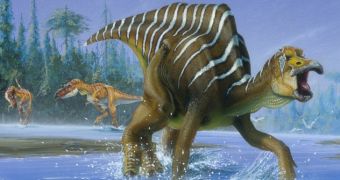Paleontologists have recently announced the discovery of hundreds of dinosaur footprints preserved in a floodplain in Alaska's Denali National Park.
The footprints are said to have been left behind by duck-billed dinosaurs, otherwise known as hadrosaurs, and have helped researchers gain a better insight into the life of these ancient creatures.
Thus, based on these tracks, it has been established that hadrosaurs not only inhabited, but pretty much thrived in ecosystems located at fairly elevated latitudes, EurekAlert tells us.
All things considered, it is highly unlikely that duck-billed dinosaurs only inhabited these ecosystems during certain times of the year. On the contrary, odds are that the region served as their permanent home.
What's more, the footprints indicate that these ancient creatures, which roamed the Earth about 69 and 72 million years ago, lived in herds that comprised both young and mature individuals.
Specifically, hadrosaurs herds comprised adults, sub-adults, juveniles, and very young specimens. Since most of the tracks were left behind by larger individuals, chances are that these dinosaurs grew at a rapid pace.
“Statistical analyses of the tracks show that individuals of four different age classes of hadrosaurids lived together in a large social group,” reads the abstract to a paper in the journal Geology documenting this find.
Thus, the researchers who found these footprints say that, whereas some of them measure as much as 64 centimeters (about 24.2 inches) in width, others are as small as 8 centimeters (roughly 3.14 inches), Whizba informs.
Interestingly enough, it appears that most of these footprints also sport skin impressions, meaning that researchers now have a better idea of what the soles of these dinosaurs' feet looked like.
What's more, some of the tracks include traces of other creatures that hadrosaurs living in present-day Alaska shared their natural habitat with. This information is expected to help deliver a more accurate picture of Earth's biodiversity millions of years ago.
“Many had skin impressions, so we could see what the bottom of their feet looked like,” study lead author Anthony R. Fiorillo with the Perot Museum of Nature and Science explains in a statement.
“There were many invertebrate traces – imprints of bugs, worms, larvae and more – which were important because they showed an ecosystem existed during the warm parts of the years,” he adds.
As detailed in the journal Geology, paleontologist Anthony R. Fiorillo has discovered these dinosaur footprints together with Stephen Hasiotis of the University of Kansas and Yoshitsugu Kobayashi of the Hokkaido University Museum.

 14 DAY TRIAL //
14 DAY TRIAL //